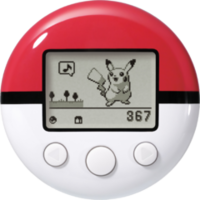| Site Notice |
|---|
|
We have a limited coverage policy. Please check our coverage page to see which articles are allowed. |
Difference between revisions of "Pokéwalker"
Torchickens (talk | contribs) |
|||
| Line 1: | Line 1: | ||
{{Product infobox | {{Product infobox | ||
| − | |image= | + | |image=[[File:Pokewalker.png|200px]] |
|caption= | |caption= | ||
|released='''JP:''' 2009<br>'''WW:''' 2010 | |released='''JP:''' 2009<br>'''WW:''' 2010 | ||
| Line 28: | Line 28: | ||
==References== | ==References== | ||
{{ref}} | {{ref}} | ||
| + | |||
| + | {{Pokémon series}} | ||
[[Category:Accessories]] | [[Category:Accessories]] | ||
Latest revision as of 16:02, 31 August 2020
| Pokéwalker | ||||||||
|---|---|---|---|---|---|---|---|---|
| ||||||||
|
The Pokéwalker is a pedometer accessory for the Nintendo DS, developed exclusively for use with copies of Pokémon HeartGold and SoulSilver Versions. The accessory was originally included with all copies of the game, before later being released individually exclusively on Nintendo's online store.
Functionally, the Pokéwalker is similar to Pokémon Pikachu 2 GS, a device which was compatible with the original Pokémon Gold and Silver Versions. A similar technology and design would later be used for the Wii U Fit Meter, included with Wii Fit U.
Features and functionality
The Pokéwalker features three buttons underneath a small monocrhome LCD screen used for play. The package also comes with a replaceable battery cover featuring a clip, allowing a player to place it on their belt. The Pokéwalker runs on a CR2032 battery, and has an estimated battery life of four months (if used for thirty minutes every day and 10,000 steps are taken).[1]
The Pokéwalker uses an infrared signal to connect to a copy of Pokémon HeartGold Version or Pokémon SoulSilver Version, as an infrared transceiver is built into the Game Card. The player can transfer one of their Pokémon between the game and the Pokéwalker, and on the Pokéwalker it will gain experience for every step taken. Steps also earn the player "watts", an in-game currency (which was also used in the Pokémon Pikachu games). Before the player begins walking, they can choose for their Pokémon to walk along one of several routes, which can be unlocked as the player walks more and which give the player different items and Pokémon, which can be transferred back to the main game.
The Pokéwalker can also connect to another Pokéwalker, which gives both players an item. Players can only connect to the same player's Pokéwalker once per day, and by connecting two Pokéwalkers that player's trainer and team will appear in the Trainer House in Viridian City in the main game.
In Japan the player could go to Pokéwalker Spots, which were inside Pokémon Center stores and would give the player items if they connected their Pokéwalker to the stand.
Trivia
- In a study conducted by Iowa State University, the results showed that the Pokéwalker's step counter was more accurate than other pedometers available at the same time.[2]
External links
References
- ↑ Pokéwalker operations manual. Nintendo. Retrieved July 13, 2016.
- ↑ Slow and steady wins the race: Pokéwalker beats other pedometers in ISU study. Iowa State University (April 15, 2011). Retrieved July 12, 2016.

